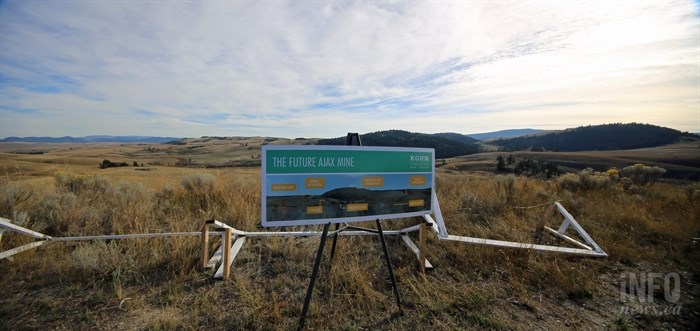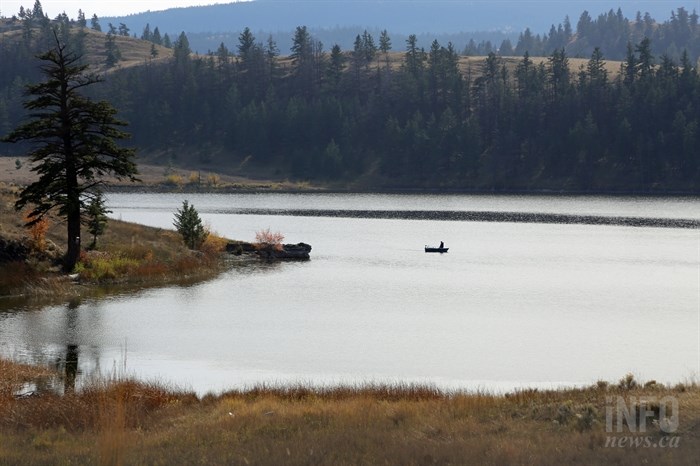
The site of the proposed Ajax Mine.
(JENNIFER STAHN / iNFOnews.ca)
January 18, 2016 - 6:02 AM
‘THEY HAVE GIVEN US CONFIDENCE WE CAN MOVE FORWARD WITH AJAX WITHOUT HAVING ANY SIGNIFICANT IMPACTS’
KAMLOOPS - The studies are complete, the application submitted and now all the company behind the proposed Ajax Mine can do is sit back and wait while government officials, experts and average Joes analyze the application — though they say they are confident their application shows the project is a good fit for Kamloops.
KGHM Ajax Mining has officially submitted its 18,000-page application for the proposed mine as of today, Jan. 18. The application package is expected to be online today and KGHM will post plain language summaries on its website Tuesday. Those summaries will also be available for viewing in its Seymour Street office, at City Hall and at both Kamloops libraries.
We will be taking a look at different elements of the application throughout the week, and today we look at the air quality and human health reports.
AIR QUALITY

Heavy smoke sits over Kamloops during wildfire season.
(JENNIFER STAHN / iNFOnews.ca)
The plain language summary provided by the company on air quality notes that based on modelling used in the studies, which included the impacts during the final year of construction and years four and eight of operation, ‘the project has little effect on the overall air quality in Kamloops’.
The air quality summary says the nearest residence — in Upper Aberdeen — is about 700 metres north of the city boundary and two kilometres from the proposed open pit and the great air quality there isn't expected to change.
“Some of the best air quality is in Upper Aberdeen today, and after the project begins… that area will still be amongst the best in the city,” air quality expert Peter Reid says, noting if people move their kids out of Pacific Way Elementary because of air quality, they’d essentially be moving their kids to a school in an area where air quality is not as good.
KGHM studies show air quality in Kamloops to be generally good, though periods of poor air quality do occur during forest fires and with winter inversions. Those periods of poor quality tend to occur in the downtown area, and the areas of Aberdeen, Westsyde and Valleyview will likely continue to have ‘cleaner’ air than Downtown even after the mine is constructed and in operation, according to Reid.
He notes the modelling used for the proposed mine is ‘one of the most comprehensive in the province to date’ because it modelled the city, as well as what the mine would contribute.
During studies, Reid says there were times where they realized mitigation would be needed to reduce the impact on the community, with roads being one of those areas.
The company plans on watering unpaved roads, using gravel or other coarse material, using covered trucks for carrying concentrate and using larger trucks to reduce the number of trips required. Other mitigation efforts will include covered conveyor belts, covered ore stockpiles, dust collectors, and reducing wind exposure and wind erosion through the placement of stockpiles and progressive reclamation.
With mitigation measures in place, the predicted increase of fine particulate matter is 2.3 per cent, which would increase the amount to 6.4 micrograms per cubic metre. According to the summary those numbers are still low enough that the city is expected to be in a ‘low health risk’ category for 97.1 per cent of the year, similar to what it is now.
“Comparing the measured and predicted (air quality health index) before and after the project demonstrates the project has little effect on the overall air quality in Kamloops,” the summary notes, adding most of the impact will be on undeveloped areas closer to the mine site.
Provincial and federal objectives outline 24-hour averages for particulate matter levels, meaning at times during the day the numbers could be higher, but as long as the daily average is below the objective air quality can be considered 'good'.
HUMAN HEALTH

Jacko Lake is a popular fishing area located within the Ajax Mine property.
(JENNIFER STAHN / iNFOnews.ca)
The human health component of the studies looked at air quality as well as water quality, dust and the food chain.
Soil and water samples were taken from around the area and 14 different metals were identified by toxicologists as having the potential from being released from the mine site as dust; antimony, arsenic, cadmium, cobalt, chromium, copper, lead, mercury, molybdenum, nickel, selenium, tin, vanadium and uranium.
Samples from local cattle, fish from Jacko Lake and Peterson Creek and produce from community gardens were used in the studies while calculations were used to figure out the impact of those metals on wild plants and game, specifically deer, grouse and showshoe hare.
The impacts of all these elements were considered for residents, people recreating in the area, ranchers and Aboriginal people. Different age groups were used in each category, but focus was put on toddler age because that age is the most susceptible to high amounts of metals.
While the amount of large particulates, PM10, is expected to increase significantly ‘on occasional days’ in the Aberdeen area, the studies all found the amount of metal in air, soil, dust and food to be within allowable limits and ‘do not represent a human health risk’.
“Toxicologists who conducted this assessment are confident the project does not present a risk to the health of people living in Kamloops or the surrounding area,” the summary says. “Further, the assumptions and calculations that were used are designed to capture the worst-case scenarios and therefore over-predict the actual level of risk. Even with this over-estimation, there are no concerns for human health risk.”
Project Manager Clyde Gillespie says some of the best experts were hired for the studies, and they were encouraged to ‘leave no stone unturned’.
“The breadth and depth of the studies are impressive,” Gillespie says. “They have given us confidence we can move forward with Ajax without having any significant impacts.”
For more stories on the proposed Ajax Mine, an open-pit copper and gold mine set to operate just southwest of Kamloops, if approved, click here.
To contact a reporter for this story, email Jennifer Stahn at jstahn@infonews.ca or call 250-819-3723. To contact an editor, email mjones@infonews.ca or call 250-718-2724.
News from © iNFOnews, 2016